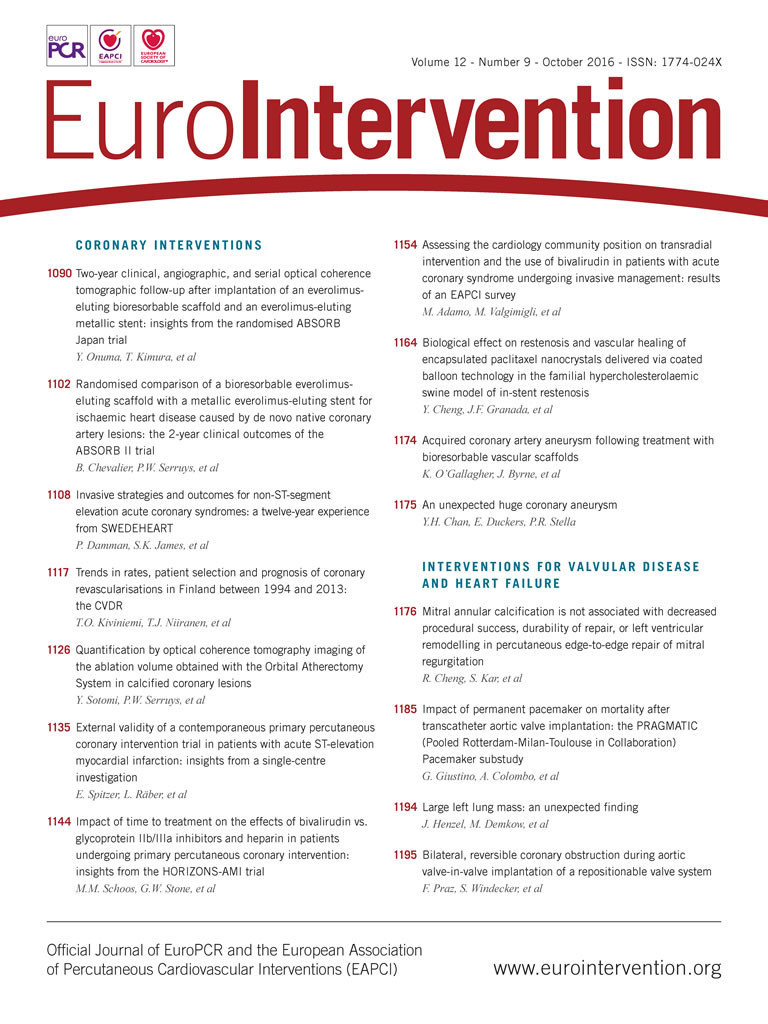
In this issue of EuroIntervention, two manuscripts are published reporting data obtained from 363,912 patients with coronary artery disease treated by revascularisation in Sweden1 or Finland2. Both articles analyse temporal trends in patient profiles and outcomes in the light of the use of PCI and CABG.
Changes in recent years are contrasted with baseline data obtained in the years 1994 or 1996, when the world was very different from today. In 1994, the Ebola virus epidemic broke out in the Congo and mad cow disease reached the UK. In 1996, the DVD was launched in Japan, the first genetically modified tomato was approved in the USA, and the cloned sheep called Dolly was born. In interventional cardiology, we were still debating the relative merits of balloon angioplasty versus stenting versus directional atherectomy. Stenting was plagued with thrombosis and restenosis, the WALLSTENT™ (Boston Scientific, Marlborough, MA, USA) and the Wiktor stent (Medtronic, Minneapolis, MN, USA) were still in use, while the heparin-coated Palmaz-Schatz stent (Cordis, Johnson & Johnson, Warren, NJ, USA) was under evaluation. Preclinical data using polymers showed excessive inflammation, and brachytherapy was anticipated as a potential solution for restenosis after years of unsuccessful attempts using systemic drug treatments.
Of note, essential data had already been collected at the time, which have allowed investigators from Sweden and Finland to assess the nationwide impact of evolving practices on patient outcome between then and today.
Findings from SWEDEHEART
Damman et al1 looked at the use of invasive strategies and outcomes at three years in 90,603 patients with NSTEMI, and in 113,489 patients with unstable angina pectoris diagnosis at discharge over a twelve-year period. Specifically, they have analysed the impact of a routine invasive strategy in relation to baseline risk estimated by the FIR risk score3. Key findings were that “the use of the routine invasive strategy increased gradually over time, resulting in increasing percentages of patients who were revascularised during the initial hospitalisation. In patients aged 70 years or older, the use of a routine invasive strategy rose from 2.5% in the period 1996-1998 to 27.5% in the period 2005-2007 (p<0.001). Comparable trends were observed in octogenarians and nonagenarians”. Mortality at three years decreased over the same time course.
The authors offer a lucid description of the strengths of the analysis as well as of the aspects that need to be interpreted with caution: the FIR integer was available for risk evaluation (not the, since then, widely recommended GRACE risk score), definitions of myocardial infarction have changed over time, and no conclusions can be drawn on the effect of very early versus early invasive diagnosis (data refer to angiography within the first three days). Importantly, the data reflect the “as treated” approach, meaning that there is potential crossover from either intended strategy because of clinical signs or symptoms. In other words, outcomes are based on “what happened”, not on “what was intended”.
The authors also wanted to evaluate the previously described treatment–risk paradox suggesting that invasive strategies were offered to low-risk groups and denied to high-risk patients, who might actually benefit the most3,4. Although the increase in early intervention remains greatest in low-risk patients, the same relative increase was observed in all risk groups, in particular in elderly patients. Physicians should be aware that their natural risk aversion should not interfere with the implementation of recommended therapies and can be controlled with the systematic evaluation of risk with the help of risk scores. At the same time, it is likely that the “as treated” analysis reflects the complexities of a decision process that considers the cardiovascular condition in addition to the holistic patient evaluation, which accounts for active and passive comorbidities, frailty, psychological situation, and patient preference.
Findings from the CVDR register in Finland
Kiviniemi et al2 set out to “investigate the 20-year trends in rates, patient selection and prognosis of coronary revascularisations in Finland”. Their analysis was based on 85,482 PCIs and 74,338 CABGs performed between 1994 and 2013. Key findings were that “despite revascularisations being performed in more challenging patients, a drastic improvement in the short- and long-term outcomes after PCI and CABG is evident” with decreases in multivariable-adjusted hazard ratios for mortality at 28 days and five years, as well as for incident myocardial infarction and stroke. “Patient selection characteristics have changed substantially over time in terms of increasing age, more frequent urgent procedures and thereby a most likely higher comorbidity burden”. During the observation period, PCI rates have increased by a factor of 4 and CABG rates have declined by two thirds.
Far-reaching lessons for doctors
The findings of these two studies are clearly very interesting, but their essential message goes even beyond specific observations. The data collection and their evaluation over the long term, as exemplified by the SWEDEHEART and the CVDR register in Finland, should be globally recognised as best practice and used as an inspiration in all healthcare delivery models.
The guideline recommendations on routine invasive strategy for high-risk patients with NSTE-ACS are based on the pooled analysis of FRISC II, ICTUS and RITA-3, i.e., the reduction in combined death and myocardial infarction rates at five years as observed in 5,467 patients enrolled in these trials3. Of note, there was only a trend in mortality reduction (hazard ratio 0.83; CI: 0.68-1.01, p=0.06). These beneficial outcomes and their applicability to a global population can now be confirmed at a nationwide level through the SWEDEHEART methodology5.
Likewise, colleagues, care providers and payers in Finland were able to merge essential data from three sources: the Hospital Discharge Register, the Finnish Drug Reimbursement Register and the Causes-of-Death Register, at a nationwide level, from 1994 onwards! Why is it that … what is possible in Sweden and Finland seems totally out of reach elsewhere? Why is it that … doctors no longer seem to be interested in understanding the impact of their practice? Certainly, the authors of this editorial cannot provide the answers to these questions. What can be stated though is that, while many of us are talking about big data, others started to collect and work with big data decades ago. In addition to obtaining confirmation of trial results at a nationwide population level, Kiviniemi et al2 explain how their analyses have impacted on adapting means to needs and influenced resource allocation, in this case the availability of interventional facilities versus surgical units. What can be more relevant for care providers, decision makers, and ultimately the citizens of a country, than being able to perform comprehensive cost efficiency analyses based on nationwide data instead of relying on myopic cost-effectiveness calculations based on a minuscule sample of highly selected trial patients?
The benefits of the SWEDEHEART programme have been beautifully summarised by S. James and O. Fröbert in their chapter on “Registry studies and post-marketing surveillance” in the PCR-EAPCI Textbook of Percutaneous Interventional Cardiovascular Medicine6.
Read it urgently, please.
Conflict of interest statement
The authors have no conflicts of interest relation to this editorial.

